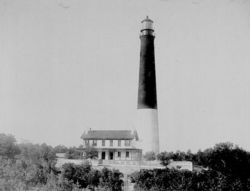Pensacola Lighthouse
 The second Pensacola Lighthouse, date unknown | |
| Location: | Entrance to Pensacola Bay |
|---|---|
| Coordinates WGS-84 (GPS) |
|
| Foundation: | granite |
| Construction: | brick |
| Year first lit: | light ship, 1823; first tower, 1825; second tower, 1859 |
| Automated: | 1965 |
| Tower shape: | conical tower |
| Height: | tower, 150 feet; 190 feet above sea level |
| Original lens: | first tower, Argand lamp with parabolic reflectors; second tower, first-order Fresnel lens |
| Range: | 27 nautical miles |
| Characteristic: | Flashing white every 20 seconds |
The Pensacola Lighthouse (or Pensacola Light) is a lighthouse located west of Fort Barrancas on the grounds of Naval Air Station Pensacola.
The first Pensacola Light was the lightship Aurora Borealis. It was moved to Pensacola in 1823 from its previous post at the mouth of the Mississippi River after a lighthouse had been completed there. Because of frequent rough seas, the lightship had to be anchored inside the bay entrance, behind Santa Rosa Island, and could not reliably be seen from ships outside the bay.
In 1825 a 40 foot tower was built on a 40 foot bluff at the south entrance to Pensacola Bay. This light was also partially obscured by trees close to the tower and on Santa Rosa Island. In 1858 a new tower was built on the north side of the bay entrance, and was lit on January 1, 1859. The new, and current, tower is 150 feet tall, and also sits on a 40 foot bluff located on Naval Air Station Pensacola, placing the light 190 feet above sea level.
The new location allowed the tower to serve as the rear range light marking the passage across the Pensacola Bar. Little is known of the first front range light. In 1879 a new front range beacon was erected 448 feet southeast of the light tower. This light, known as the Pensacola Bar Beacon, was a square pyramidal wooden tower, 26 feet tall, sitting on a point 29 feet above sea level, so that the light was 55 feet above the water. It had a sixth order Fresnel lens, and showed a fixed white light visible for 11 miles. The Pensacola Bar Beacon was removed from service and demolished some time in the early 1900s.
At the start of the Civil War, Pensacola was controlled by Confederate forces, while Fort Pickens across the bay remained in Union hands. Confederate authorities removed the lens from the lighthouse, and most of the lighthouse supplies were requisitioned for the war effort. In November of 1861 an artillery duel between the two forces damaged the lighthouse tower.
Confederate forces later evacuated Pensacola, and were replaced by Union forces. In 1863 the Pensacola Light was relit using a fourth-order Fresnel lens. A new first-order lens was placed in the tower in 1869. The tower was all white during the Civil War. Later, the upper two-thirds of the tower was painted black. Electricity was introduced to the lighthouse in 1939, eliminating the need to rewind the light rotation clockworks every 4 1/2 hours. the light was automated in 1965. The lighthouse tower and associated buildings were placed on the National Register of Historic Places in 1974.
The Coast Guard Auxiliary Flotilla 17 gave tours of the lighthouse until 2006, but announced in May 2007 that they were cancelling tower tours for liability reasons.[1] However, in 2008, tours were reinstated by the Pensacola Lighthouse Association, which offers tours on Saturdays between May and October, including allowing visitors to climb the 177 steps to the top.[2]
Other images[edit]
circa 1905
External links & eferences[edit]
- Historic American Buildings Survey (Library of Congress) Survey number HABS FL-147
- U.S. Coast Guard, Pensacola Auxillary
- McCarthy, Kevin M. (1990). Florida Lighthouses, Paintings by William L. Trotter, Gainesville, Florida: University of Florida Press. ISBN 0-8130-0982-0.
- National Park Service Inventory of Historic Light Stations - Florida Lighthouses - retrieved February 3 2006
- U.S. Coast Guard Historic Light Station Information & Photography - Florida - retrieved February 3 2006
- Pensacola Lighthouse History - retrieved February 3 2006
- AMATEUR RADIO LIGHTHOUSE SOCIETY - List of Lighthouse Coordinates - retrieved February 3 2006
- Lighthouse Depot - Pensacola Bar Beacon - retrieved February 7 2006
- Pensacola Lighthouse Tours - retrieved June 15 2006
- ↑ Lighthouse cancels tours - Pensacola News Journal, May 2, 2007
- ↑ A guiding light - Pensacola News Journal, January 4, 2009
